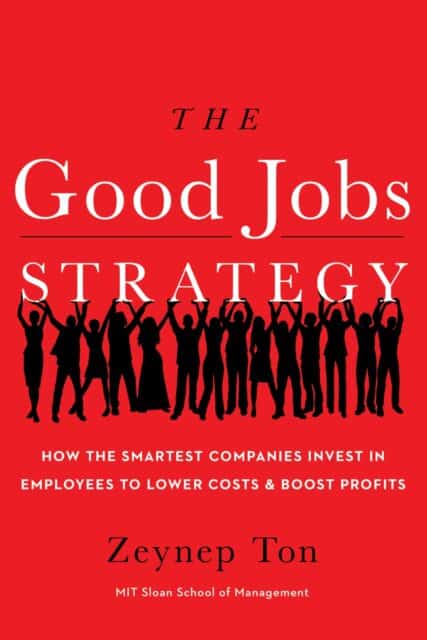It can be tempting for business leaders to think that investing in employees – paying better than average wages, give them an opportunity to utilize their strengths and skills, staffing appropriately, giving time off – are just kumbaya.
As in, those things don’t really matter to the bottom line.
Thank goodness for author Zeynep Ton who infuses some sanity into this discussion. In the book The Good Jobs Strategy: How the Smartest Companies Invest in Employees to Lower Costs and Boost Profits, she lays out an unassailable case for how providing good jobs is not only a nice thing to do, but it’s actually a strategic advantage.

Why The Good Jobs Strategy belongs in every founder’s playbook
At its heart, MIT professor Zeynep Ton’s book makes a simple—but often counter-cultural—claim: “Great companies don’t win in spite of their frontline teams; they win because of them.” Ton calls the race-to-the-bottom approach of low wages and chaotic schedules the bad-jobs system and shows how it traps businesses in high turnover and low performance. In the U.S., almost 1 in 4 workers earns less than a living wage, so this isn’t a fringe problem—it’s the soil many of our businesses are planted in.
The blueprint: invest in people and tune your operations
Ton’s research uncovers four operational choices that let you pay more and outperform on cost, service, and growth:
-
Focus & Simplify – ruthlessly prune SKUs, promos, and complexity.
-
Standardize & Empower – give clear playbooks and the authority to improve them.
-
Cross-Train – build agile teams who can flex to real-time demand.
-
Operate with Slack – schedule a pinch of extra labor so people can prevent fires instead of constantly fighting them.
These choices create a virtuous cycle: better-equipped employees drive higher productivity, which funds even better jobs.
Proof it pays
| Company | People Investment | Performance Payoff |
|---|---|---|
| Costco | Wages ~40 % higher than Sam’s Club | Sales per employee nearly double Sam’s Club’s, with operating profit per hourly worker almost 2× higher. ilsr.org |
| Trader Joe’s | Full-timers earn 2× competitors’ pay | Sales per labor hour 40 %+ higher; sales per sq ft 3× the U.S. grocery average. ilsr.org |
| QuikTrip | “Pay people more than they expect.” — Co-founder Chester Cadieux | Turnover 13 % vs. industry 59 %; sales per labor hour 50 % higher than peers. ilsr.orgnextbigideaclub.com |
These aren’t boutique brands with premium price tags—they compete on low prices and high service, proving the margin is inside the model, not added on top.
Three take-aways for growth-minded entrepreneurs
-
Labor isn’t a cost line; it’s your most leveraged asset. Jim Sinegal of Costco reminds us, “Seventy cents of every dollar we spend to run our company goes to people.” Treat that spend like venture capital in human potential, not overhead.
-
Complexity is the silent killer. Every SKU, coupon, or new feature either amplifies or erodes frontline effectiveness. Ask Ton’s favorite question before any launch: “How will this make our employees’ work easier to execute with excellence?”
-
Start the flywheel, don’t chase the spreadsheet. Many leaders fear higher pay without first modeling precise ROI. Ton shows that incremental moves—raising pay for a key role and trimming low-value tasks—unlock quick wins that fund the next round of improvements. Quest Diagnostics cut turnover by 50 % and Sam’s Club bumped productivity ~20 % with this crawl-walk-run approach.
The appreciative lens
What I love here is how Ton reframes jobs not as a charity expense but as an engine of flourishing—for customers, communities, and capital alike. Her data dismantles the false choice between doing right by people and doing well in business. For founders who believe companies can be “beautiful,” The Good Jobs Strategy hands us a rigorously researched, values-aligned roadmap for building the kind of organizations our teams—and our balance sheets—will thank us for.
Yes, it costs more, but the benefits are overwhelming (and surprising). From higher rates of job satisfaction, to increased retention, to increased profit margins and more satisfied customers.
More and more, the Good Jobs Strategy is not just a “nice to have” but a “must have.”
How can you leverage the Good Jobs Strategy in your context?